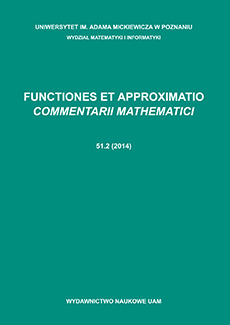Abstract
Given an additive function $f$ and a multiplicative function $g$, let $E(f,g;x)=\#\{n\le x: f(n)=g(n)\}$. We study the size of $E(f,g;x)$ for functions $f$ such that $f(n)\neq 0$ for at least one integer $n>1$. In particular, we show that for those additive functions $f$ whose values $f(n)$ are concentrated around their mean value $\lambda(n)$, one can find a multiplicative function $g$ such that, given any $\varepsilon>0$, then $E(f,g;x)\gg x/\lambda(x)^{1+\varepsilon}$. We also show that given any additive function satisfying certain regularity conditions, no multiplicative function can coincide with it on a set of positive density. It follows that if $\omega(n)$ stands for the number of distinct prime factors of $n$, then, given any $\varepsilon>0$, there exists a multiplicative function $g$ such that $E(\omega,g;x)\gg x/(\log\log x)^{1+\varepsilon}$, while for all multiplicative functions $g$, we have $E(\omega,g;x)=o(x)$ as $x\to \infty$.
Citation
Jean-Marie De Koninck. Nicolas Doyon. Patrick Letendre. "On the proximity of additive and multiplicative functions." Funct. Approx. Comment. Math. 52 (2) 327 - 344, June 2015. https://doi.org/10.7169/facm/2015.52.2.10
Information





